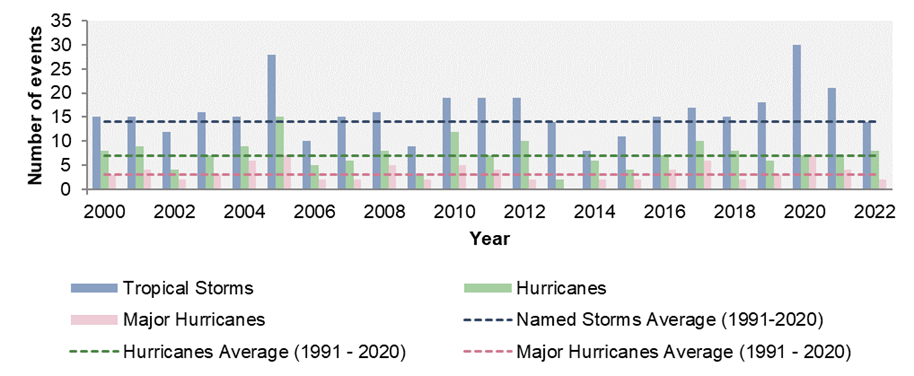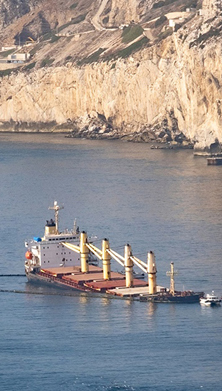As the wind blows
Despite the pre-season forecasts of an above-average season, the 2022 Atlantic season ended up being near-average. Nonetheless, Hurricane Ian, which struck Cuba and the south-eastern US in late September, became the third costliest hurricane on record.
The 2023 Atlantic hurricane season begins on June 1 and officially runs until 30 November. Early forecasts from AccuWeather, Colorado State University (CSU), National Oceanic and Atmospheric Administration (NOAA), North Carolina State University (NCSU), and Tropical Storm Risk (TSR) point to a slightly below-average season this year. However, uncertainties remain and there is still the potential for an active season.
By March 2023, the tropical Pacific had transitioned to neutral El Niño conditions (see panel). Most research institutions agree a transition to El Niño conditions is likely during this year’s hurricane season – NOAA predicts a 62% chance El Niño will develop sometime between May and July [1]. When a robust El Niño event develops, it can reduce Atlantic hurricane activity by increasing vertical wind shear. However, it is not yet clear how intense the El Niño event could be, and considering that there is potential for an above-normal west African monsoon (which seeds some of the stronger and longer-lived Atlantic storms), and that sea surface temperatures (SSTs) in the tropical Atlantic and Caribbean are much warmer than normal, the potential for an active Atlantic hurricane season still exists. [2]
Hurricane season 2023: predictions by institution
Swipe to view more
|
Source*
|
Forecast publish date
|
Tropical storms**
|
Hurricanes**
|
Major hurricanes**
|
US storm landfalls
|
US hurricane landfalls
|
Rating
|
|---|---|---|---|---|---|---|---|
| NOAA (long-term norm 1991 - 2020 | 14 | 7 | 3 | 3.3 | 1.5 | Long-term normal | |
| AccuWeather* | March 29 | 11-15 | 4-8 | 1-3 | 2-4 | --- | Below average |
| CSU* | June 1 | 15 | 7 | 3 | --- | --- | Near normal |
| TSR* | May 31 | 13 | 6 | 2 | 4 | 1 | Slightly below average |
| NOAA* | May 25 | 12-17 | 5-9 | 1-4 | --- | --- | Near normal |
| NCSU* | April 13 | 11-15 | 6-8 | 2-3 | --- | --- | Average |
| 2023 Forecast range | 11-17 | 4-9 | 1-4 | 2-4 | 1 | Slightly below average | |
| Comparison: 2022 hurricane season forecast (average) | 18 | 8 | 5 | 5 | 2 | Above average | |
| Comparison: 2022 hurricane season (actual) | 14 | 8 | 2 | 3 | 2 | Near normal |
**Tropical storm: > 39 mph (> 63 km/h); Hurricane: > 74 mph (> 119 km/h); Major hurricane: Categories 3-5, > 111 mph (> 178 km/h).
What is the El-Niño Southern Oscillation (ENSO)?
ENSO is a natural fluctuation [4] in the sea surface temperature and air pressure across the Pacific Ocean with knock-on effects on weather patterns worldwide.
The El Niño phase of the cycle is based on warmer than usual SSTs in the equatorial Pacific, which favors stronger hurricane activity in the central and eastern tropical Pacific Ocean but suppresses it in the Atlantic basin. Conversely, La Niña, which is characterized by colder SSTs in the equatorial Pacific, suppresses hurricane activity in the central and eastern Pacific Ocean, while enhancing it in the Atlantic basin. During a neutral phase, tropical Pacific SSTs are close to average.
2022 hurricane season in review
Although the pre-season forecasts predicted an above-average season, the 2022 Atlantic hurricane season turned out to be near-average, with 14 named storms, including eight hurricanes, two of which intensified to major hurricane status – Fiona and Ian. An average hurricane season would typically see 14 named storms, seven hurricanes and three major hurricanes. This was the first near-average season since 2015.
One of the most outstanding features of the 2022 season was the rare mid-way pause between July and early September. This was driven by, among other factors, an excess of Saharan dust over the Main Development Region off the coast of Africa (leading to lower atmospheric moisture), increased vertical wind shear across the Caribbean Sea and central North Atlantic, and the propagation of the suppressed phase of the Madden-Julian Oscillation across the basin, which favors warm, dry air and reduced rainfall. All these factors contributed to a generally more stable atmosphere [5], which inhibited the formation of cyclones.

2022 hurricane season numbers in a nutshell
- Despite the fact that 2022 was a near-normal hurricane season in terms of number of storms, the economic and insured losses caused by Hurricane Ian led to it being the third costliest season on record [6] [7] [8].
- The activity during August was the lowest in the last 25 years. Since the satellite era began in 1960 there have been only three years with no named storms during August, namely 1961, 1997 and 2022 [9]. It was the first time since 1941 that the Atlantic saw no named storm activity between July 3 and August 31.
- For the seventh consecutive year, at least 14 named storms were formed.
- This was the first Atlantic hurricane season not classified as above-average since 2015.
- The accumulated cyclone energy (ACE – a measure of a named storm’s potential for wind and storm surge destruction) in October was the lowest generated since 2009.
- Three hurricanes formed during November: Lisa, Martin, and Nicole. This matched the 2001 season for the highest number of hurricanes formed during November. Hurricane formation is typically less common during November, which is the last month of the hurricane season.
- Hurricane Ian tied with five other hurricanes for the fifth strongest continental US hurricane landfall on record, with maximum sustained winds of 241km/h (150mph/130kt).
- Hurricane Fiona made landfall in Nova Scotia as a post-tropical cyclone with an estimated central pressure of 931hPa, making it the lowest recorded pressure for a landfalling storm in Canada (lower pressures are associated with stronger storms).
- Hurricane Nicole made landfall in the US on November 10, making it the latest calendar year hurricane to make landfall along the east coast of Florida on record [10].
Hurricane Ian
The zone of western Florida where Ian made landfall has experienced a rapid urbanization and population growth in the last 50 years. Since 1970, the metro area of Cape Coral – Fort Meyers has increased by 620% [12]. In addition to the high population density, the building stock’s vulnerability to storm surge, along with Ian’s track and large storm size, compounded the widespread devastation. The economic loss of Ian has been estimated at US$114bn [13] while the insured losses are deemed to be between US$50bn [14] and US$74bn [15]. This makes it the third costliest hurricane on record, behind Katrina (2005) and Harvey (2017).
A large portion of the losses arising from Hurricane Ian was driven by wind damage. After hurricanes Charley (2004) and Irma (2017), stricter building standards were put into place in Florida. Following Hurricane Irma, many properties had their roofs replaced, leading to enhanced resistance to wind damage. Without these enhancements, the losses from wind damage due to Ian would likely have been even higher. However, the region remains highly vulnerable to storm surge. Ian produced a catastrophic storm surge along the southwest coast of Florida, especially the area between Cape Coral – Fort Myers and Naples, where it reached maximum inundation levels of 4.6m (15ft) and affected properties up to 0.5km (0.3 miles) inland.
Accuracy of pre-season forecasts in 2022
There was general agreement between the pre-season forecasts released by AccuWeather, CSU, NOAA, NCSU, and TSR that the 2022 season would be above-average. However, more difficult-to-predict factors such as the presence of Saharan dust as well as SST and wind shear anomalies ultimately led to the near-average 2022 Atlantic hurricane season.
During 2022 La Niña conditions prevailed, which would normally lead to favorable conditions for increased Atlantic tropical cyclone activity (see panel). However, the peak of the 2022 hurricane season saw warmer-than-normal tropical SSTs and anomalously cool SSTs in the subtropical Atlantic. This combination may have favored atypical increases in vertical wind shear, especially during August, resulting in a hindered storm activity [16].
The 2022 hurricane season was a reminder that even in a “quiet” season, a single storm like Ian can cause significant losses for the insurance market if it strikes with a certain set of circumstances. Hurricane Ian was also a salutary lesson in how improvements to building standards can enhance building performance and boost resilience to natural catastrophes.
How to prepare for when a storm strikes
A single storm can cause catastrophic damage locally and the National Hurricane Center in the US advises that preparedness plans should not be based on seasonal forecasts. When a hurricane watch is issued for your area, you need to ‘Know Your Zone’ (vulnerable areas will be given an evacuation warning or order) and be aware that authority-ordered evacuation is based on the possibility of storm surge and flooding, rather than pending landfall of a storm.
Although hurricanes are strongly associated with the US, businesses elsewhere in the world also need to be on their guard against typhoon activity and storm and flood damage.
To minimize losses in the event of an extreme weather event, businesses should implement a written emergency plan, including actions to take before, during, and after a storm.
The plan should cover areas such as training, emergency supplies, business continuity, building inspections, anchoring or relocating equipment and stock, protecting windows, flood protection, salvage and recovery, and damage assessment. If you are in the US, visit National Hurricane Preparedness for more information about how to determine your risk and develop an evacuation plan.
Allianz Risk Consulting publishes a series of risk bulletins and checklists to help you protect your people, property, and business, including: Windstorm Checklist, Flood Checklist, Water Damage During Construction, Water Damage Prevention Solutions, Hailstorm Checklist, and Business Continuity Planning Best Practice.
See also Superstorm Sandy - 10 years on for five steps to boost storm resilience.
References
[1] NOAA, What to Watch for: El Nino Likely to Develop this Summer, April 13, 2023
[2] NOAA, NOAA Predicts a Near-Normal 2023 Atlantic Hurricane Season, May 25, 2023
[3] Tropical Storm Risk (TSR), April Forecast Update for North Atlantic Hurricane Activity in 2023, April 6, 2023
[4] NOAA, What is the El Niño–Southern Oscillation (ENSO) in a Nutshell?, May 5, 2014
[5] Moody’s RMS, 2022 North Atlantic Hurricane Season Halftime Report: The Quiet Before the Storm?, August 17, 2022
[6] Wikipedia, List of Costliest Atlantic Hurricanes
[7] National Centers for Environmental Information, NOAA, Events - Billion-Dollar Weather and Climate Disasters
[8] Swiss Re Institute, Sigma, Natural Catastrophes and Inflation in 2022: a Perfect Storm, March 22, 2023
[9] AccuWeather, Zero Named Storms in Atlantic Basin During August for 1st Time in 25 Years, September 1, 2022
[10] Colorado State University, Summary of 2022 Atlantic Tropical Cyclone Activity and Verification of Authors’ Seasonal and Two-Week Forecasts, November 28, 2022
[11] NOAA, National Hurricane Center Tropical Cyclone Report, Hurricane Ian, April 3, 2023
[12] Swiss Re Institute, Sigma, Natural Catastrophes and Inflation in 2022: a Perfect Storm, March 22, 2023
[13] National Centers for Environmental Information, NOAA, Events - Billion-Dollar Weather and Climate Disasters
[14] Swiss Re Institute, Sigma, Natural Catastrophes and Inflation in 2022: a Perfect Storm, March 22, 2023
[15] Moody’s RMS, RMS Estimates US$67 Billion in Insured Losses from Hurricane Ian, October 7, 2022
[16] Colorado State University, Summary of 2022 Atlantic Tropical Cyclone Activity and Verification of Authors’ Seasonal and Two-Week Forecasts, November 28, 2022
Pictures: AdobeStock
Our expert
Newsletter
Keep up to date on all news and insights from AGCS

















